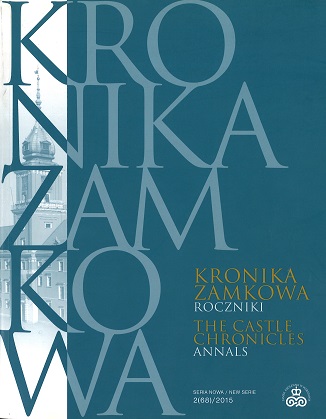Ze zbiorów Fundacji Teresy Sahakian : XVII-wieczna holenderska szafa typu beeldenkast, czyli moralizatorski traktat dla nowożeńców
From the collection of the Teresa Sahakian Foundation: A seventeenth century Dutch Cabinet of the bleedenkast type, or a moralizing treatise for newly-weds
Author(s): Maciej ChoynowskiSubject(s): Fine Arts / Performing Arts, History of Art
Published by: Arx Regia® Wydawnictwo Zamku Królewskiego w Warszawie – Muzeum
Keywords: Dutch beeldenkast cabinet; decorative arts; furniture; St John the Baptist – iconography; Maarten van Heemskerck; Philips Galle; The Teresa Sahakian Foundation
Summary/Abstract: Of the more than 750 works of art in the collection of the Teresa Sahakian Foundation— known, above all, for its famous collection of Oriental rugs and textiles—the smallest collection is one of ten pieces of European furniture. The majority are Dutch and Flemish pieces dating from the seventeenth and first half of the eighteenth century. They were given to the Royal Castle in Warsaw in 2012, after the founder’s death. The Renaissance piece is of special interest; a twotier cabinet made around 1640–1650, very typical of Dutch interiors of that time. The front of the cabinet is decorated with bas-relief panels with scenes from the life of St John the Baptist; in the upper tier there are personifications of the Christian virtues: Faith (Fides), Hope (Spes) and Charity (Caritas), and in the lower tier are David with the head of Goliath, Prosperity (Abudantia) and Fortune (Tyche) These personifications take the form of sculpted statuettes. This type of decoration is now described in the Netherlands as beeldenkast. The symbolism of the cabinet’s sculpted decoration can be interpreted in general terms as encouraging a life built upon faith and the defending of family values (St John), and based on Christian virtues, whilst retaining reflection and restraint (David), which should bring prosperity, fertility and good fortune, thus guaranteeing the continuity of a happy family (Fortune, Prosperity). It was possible to establish that the authors of the original models for the scenes with St John were two exceptional sixteenth-century Dutch artists: etchings were made of paintings by Maarten van Heemskerck (1498–1574) which were published in 1564 in book form by the printmaker Philips Galle (1537–1612). Cabinets were often given as part of the dowry to young newly-weds and displayed in reception rooms. Richly-decorated, they were a symbol of the financial status the family had attained through their hard work; they testified to the owners’ good (modern) taste and their knowledge of the Christian virtues. They also highlighted the importance of the lady of the house, who oversaw the management of the household and the possessions inside the home. The cabinet under discussion has been included in the exhibits at the Royal Castle and is an invaluable example of craftsmanship in the Dutch Golden Age.
Journal: Kronika Zamkowa. Roczniki
- Issue Year: 2/2015
- Issue No: 2
- Page Range: 245-265
- Page Count: 21
- Language: Polish

